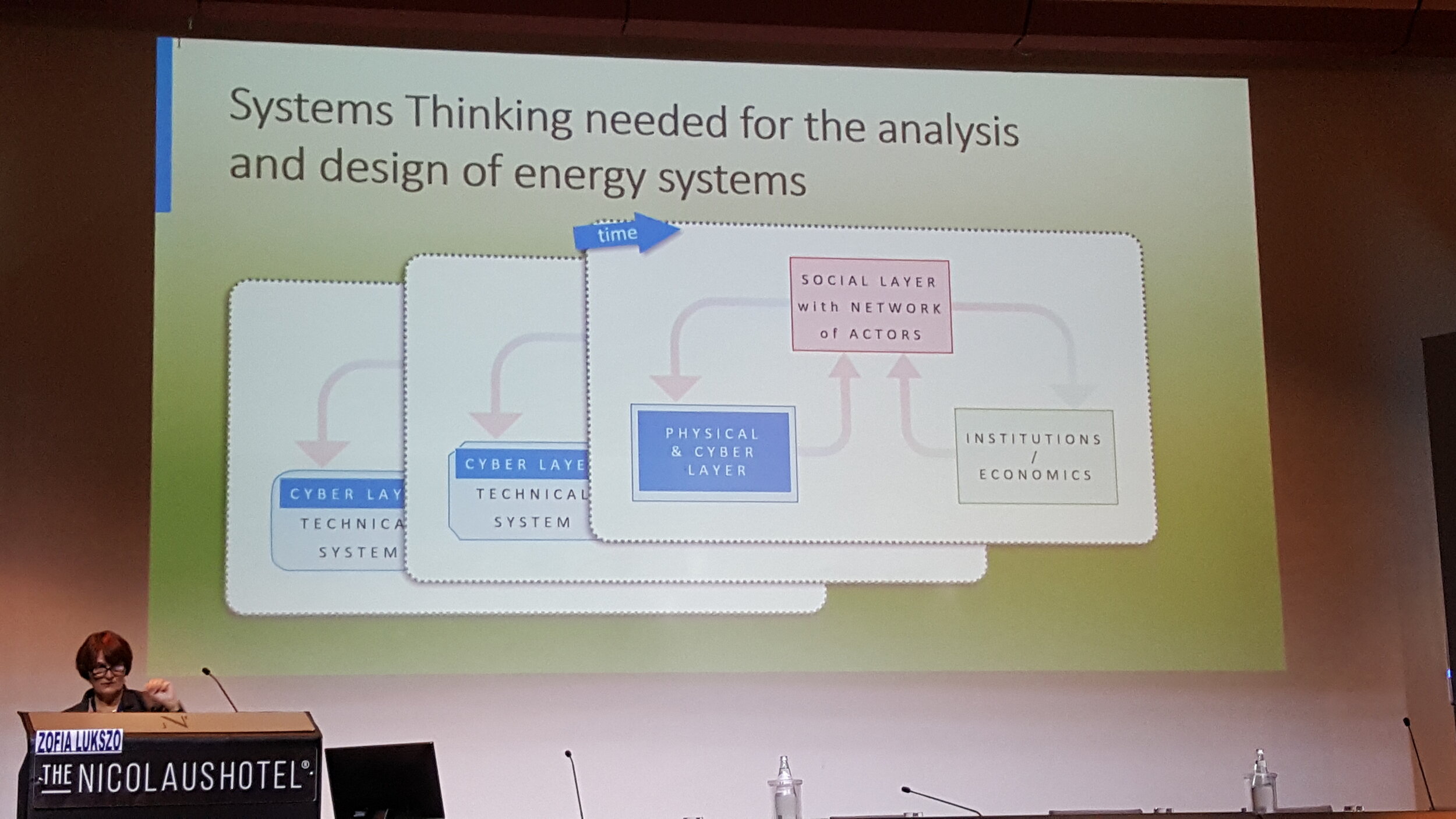Tutorial: Applying Systems Thinking to Industry 4.0
For: 2019 IEEE International Conference on Systems, Man and Cybernetics (SMC)
When: October 6, 2019 – Bari, Italy
I had the honor of doing a tutorial called Applying Systems Thinking to Industry 4.0 for 2019 IEEE International Conference on Systems, Man and Cybernetics (SMC) in Bari, Italy. It turned out better than I expected (around 35) and the reception was better than I hoped (no one fell asleep). The audience asked insightful and thoughtful questions, which is always a sign that they are engaged.
I did run out of time and only did the first half of "Draw Toast" exercise. To see what I was trying to accomplish see Tom Wujec’s TED talk at his Systems Thinking Website http://www.drawtoast.com/
By the way - to emphasize the importance of Systems Thinking, Professor Zofia Lukszo, the Plenary Speaker for Wednesday, spoke about how the complex energy system can be (re-)shaped for a sustainable future, BUT it will take SYSTEMS THINKING. Yes, it was yet another call to use Systems Thinking to address out complex socio-technical problems.
Professor Zofia Lukszo, says Systems Thinking is needed to address complex socio-technical problems.
More Info on Applying Systems Thinking Tutorial
Videos Used:
Main References
Cabrera, Derek & Cabrera, Laura. (2015). Systems Thinking Made Simple: New Hope for Solving Wicked Problems
Senge, P.M. (1990, 2006) The Fifth Discipline: The Art and Practice of the Learning Organization.
Sweeney, L.B. & Meadows, D. (2010) The Systems Thinking Playbook: Exercises to Stretch and Build Learning and Systems Thinking Capabilities
Wujec, T. Draw Toast: A Primer in Systems Thinking Website http://www.drawtoast.com/
Other References:
Sillitto, H. (2012), 4.3.2 Integrating Systems Science, Systems Thinking, and Systems Engineering: understanding the differences and exploiting the synergies. INCOSE International Symposium, 22: 532–547
Castellani B, Hafferty FW. 2009. Sociology and Complexity Science: A New Field of Inquiry. Springer: Berlin. http://www.art-sciencefactory.com/complexity-map_feb09.html [last accessed 9/28/19]
M'pherson, P. K. "A Perspective on Systems Science and Systems Philosophy." Futures 6.3 (1974): 219-39
von Bertalanffy, L. 1968. General System Theory: Foundations, Development, Applications. Revised ed. New York, NY, USA: George Braziller, Inc..
ISO/IEC/IEEE 15288:2015 Systems and software engineering -- System life cycle processes
Systems Engineering and System Definitions | INCOSE-TP-| 22 July 2019
Wikipedia definition of System - https://en.wikipedia.org/wiki/System - [last accessed 9/28/19]
Checkland, P. 1999. Systems Thinking, Systems Practice.
Ellison, Harlan and Roy Thomas (w), Herb Trimpe (p) Sam Grainger (i). "The Brute ... That Shouted Love... At the Heart of the Atom." Incredible Hulk Vol 1 #140 (June 1971), Marvel Comics.
Eames Office. (2010, Aug 26). Powers of Ten™ (1977) [Video file]. Retrieved from https://youtu.be/0fKBhvDjuy0
Abumrad, Jad and Robert Krulwich (Host). (2005, March 4). "Beyond Time" [Audio podcast - RadioLab, Season 1, Episode 5]. Retrieved from http://www.radiolab.org/story/91504-beyond-time/
"What is Systems Thinking?" and “Concepts of Systems Thinking” in BKCASE Editorial Board. 2019. The Guide to the Systems Engineering Body of Knowledge (SEBoK), v. 2.0 R.J. Cloutier (Editor in Chief). Hoboken, NJ: The Trustees of the Stevens Institute of Technology. Accessed [9/28/2019]. https://www.sebokwiki.org/. BKCASE is managed and maintained by the Stevens Institute of Technology Systems Engineering Research Center, the International Council on Systems Engineering, and the Institute of Electrical and Electronics Engineers Computer Society.
Meadows, D. 2008. Thinking in Systems: A primer. White River Junction, Vermont: Chelsea Green Publishing.
O’Shaughnessy, P.T.; Website http://catdrop.com/ the flying cat story Or “operation cat drop” A history of this often-told tale
Magnin, Alex: Video: Systems thinking: A cautionary tale - https://www.alexandremagnin.com/main/en/portfolio/systems-thinking-a-cautionary-tale/
Classic old or young woman illusion - first appeared on an 1888 German postcard and was later adapted by British cartoonist William Ely Hill, who published it in a humor magazine in 1915 with the title "My Wife and My Mother-in-Law."
Pirsig, R. M. (1974). Zen and the art of motorcycle maintenance: An inquiry into values. New York: Morrow.
Ackoff R.L. 1960. Systems, organizations and interdisciplinary research. General Systems Yearbook 5: 1–8.
Senge, P.M., A. Klieiner, C. Roberts, R.B. Ross, and B.J. Smith. 1994. The Fifth Discipline Fieldbook: Strategies and Tools for Building a Learning Organization. New York, NY, USA: Currency Doubleday.
Science References:
Copernicus (1473 -1543)
Copernicus (1543) De revolutionibus orbium coelestium (On the revolutions of the celestial spheres)
The heliocentric model of universe
Bacon (1561-1626)
Bacon, F. (1620). Novum organum.(New Instrument)
Father of empirical experimentation
Descartes (1596-1650)
Descartes, R. (1637) A Discourse on Method
Rational methodology, reductionism
Newton (1643 - 1727)
Newton, I. (1687) Philosophiae naturalis principia mathematica (Mathematical Principles of Natural Philosophy)
First Physicist
Systems Science References:
Wiener, N. (1948). Cybernetics or control and communication in the animal and the machine. New York: M.I.T. Press.
Churchman, C.W., R.L. Ackoff, and E.L. Arnoff. 1950. Introduction to Operations Research. New York, NY, USA: Wiley.
Bertalanffy, L. V. (1951). General system theory: a new approach to unity of science. Baltimore: John Hopkins Press.
Forrester, Jay W. (1961). Industrial Dynamics. Cambridge, MA, USA: MIT Press.
Koestler, A. (1967). The Ghost in the Machine. New York: Macmillan.
Checkland, P. (1981). Systems thinking, systems practice. Chichester: J. Wiley.
Senge, Peter M. 1990 The Fifth Discipline: The Art and Practice of the Learning Organization. New York, Doubleday/Currency.
Emergence References:
Andersen, H. (2001). The history of reductionism versus holistic approaches to scientific research. Endeavour, 25(4), 153-156.
Early Emergence references:
Mill, J. S. (1843). A system of logic: ratiocinative and inductive. London: John W. Parker.
Lewes, G. (1875). Problems of life and mind. London: Kegan Paul, Trench, Turbner.
Smuts, J. C. (1926). Holism and evolution. New York: The Macmillan Company.
Abstract:
As Systems Engineers face the task to enable the fourth industrial revolution with new systems and products, they are finding their traditional practices insufficient in taking into the account of the complexity and interconnectedness of the new trends in automation, system sciences, and cyber-physical systems. Traditional systems engineering has focused on analysis and reductionism in order to reduce the complexity and better understand the system they are trying to create. However, Industry 4.0 and “smart factories” requires a new emphasis on the System being able to work within an even greater System. This means Systems Engineers must now focus on Systems Thinking as a way to look outward and concentrate on using synthesis as a means to understand the system they are trying to create and place within a larger context. This 2-hour tutorial will discuss System Thinking Perspectives and how to apply these perspectives to situations and problems so they can be framed and reframed in different ways, thus allowing for new kinds of solutions to be considered.



